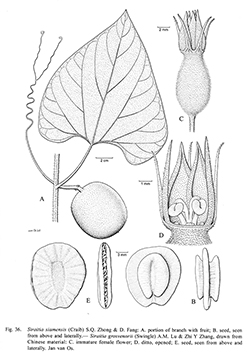e-Flora of Thailand
Volume 9 > Part 4 > Year 2008 > Page 501 > Cucurbitaceae > Siraitia
2. Siraitia siamensis (Craib) S.Q.Zhong & D.Fang Guihaiawfo-0001219141
4(1): 23. 1984; S.K.Chen in C.Y.Wu, C.Chen & S.K.Chen, Fl. Yunnan. 6: 311, fig. 81: 1–9. 1995; W.J.de Wilde & Duyfjes, Blumea 51: 501.— Thladiantha siamensis Craib, Bull. Misc. Inform. Kew: 7. 1914; Fl. Siam. 1: 759. 1931; Keraudren in Aubrév. & J.-F.Leroy, Fl. Cambodge, Laos & Vietnam 15: 34, fig. 10: 5–7. 1975; P.H.Hô, Câyco Vietnam 1, 2: 715, f. 1983. 1991. Fig. 35; 36: A-B.
Accepted Name : This is currently accepted.
Synonyms & Citations :
Description : Climber with one (or few) shoots to 5(–10) m long from a supra-terranean club-shaped or ovoid tuber to 25 cm diam.; leafy stem subterete or ± angular, 3(–6) mm thick, with long or short hairs. Tendrils finely pubescent. Leaves: blade ovate, 9–30 by 8–22 cm, upper surface sparsely appressed-hairy, lower surface variously pubescent and with many blackish glandular hairs, cystoliths not obvious, base deeply cordate, margin sparsely minutely dentate, apex acute-acuminate; petiole 4–10 cm, long-hairy. Male inflorescences a simple or once branched raceme, (10–)20 cm, the flowers ± crowded at the apex of the inflorescence branches; bracts minute, 1(–2) mm or mostly absent; peduncle 5–13 cm; all parts finely pubescent; female flowers solitary (or 2) in a reduced raceme to 1 cm. Male flowers finely pubescent; pedicel 15–30 mm; receptacle-tube bowl-shaped, shallow, ca 10 by 5 mm; disc not obvious, but bottom of receptacle-tube ± thickened; sepals triangular, ca 5 by 5 mm, apex obtuse or subacute, receptacle and sepals outside with conspicuous anastomosing-netted veins; petals broadly elliptic, (10–)15 mm, 4–8 mm wide at base, apex rounded, inner surface finely papillose, at base with 2 large and 2 or 3 smaller scales, these together with the thickened bases of the filaments concealing the hollow of the receptacle-tube; stamens erect or curved; filaments 5–7 mm long; anthers ca 4 mm long, one arm shorter. Female flowers: pedicel 10(–20) mm; ovary ovoid-ellipsoid, ca 10 mm, hairy; perianth as in male flowers; style (China) 4–5 mm, 3-lobed. Fruit solitary, subglobose, 5–8 cm diam., hairy, partly glabrescent; pericarp thin, ca 1 mm thick, woody; fruit pulp whitish, enclosing numerous densely packed seeds. Seeds ca 15 mm diam., pale brown, corky, with broad 3-plicate rim, the middle rim largest, the proper seed (without rim) elliptic in outline, ca 8 mm long.
Field-note.— Young leaves and twig apices are purplish reddish.
Thailand : NORTHERN: Chiang Mai (Doi Suthep NP – type: Kerr 1171, holotype -K, isotype -E; Doi Inthanon NP); Nan (Doi Phu Kha NP); SOUTH-EASTERN: Chachongsao (Khao Hin Son BG); Rayong (Khao Cha Mao NP); Chanthaburi (Khao Kitchakut NP, Khao Soi Dao); Trat (Ko Chang); PENINSULAR: Nakhon Si Thammarat (Khao Luang NP).
Distribution : Widespread, from S China through Indochina into W Malesia (Peninsular Malaysia, Sumatra, Borneo, Java).
Ecology : Open or disturbed places in evergreen forests, hill dipterocarp forests on acid rock, forests edges, scrub, 0–1,500 m alt. Flowering: April; fruiting: May, September, November.


